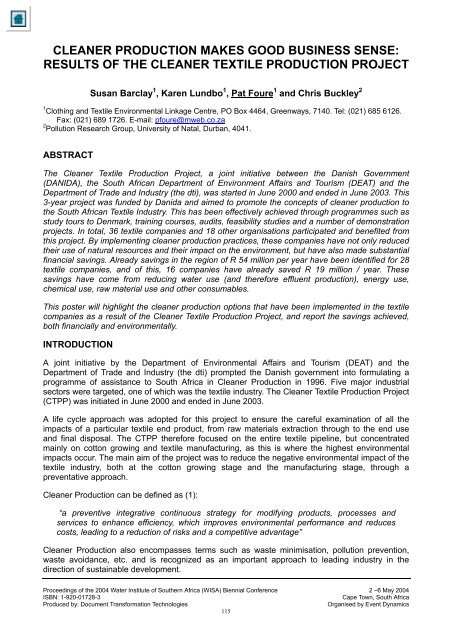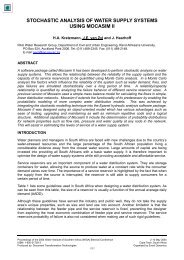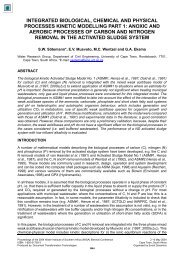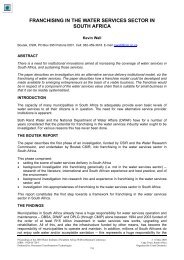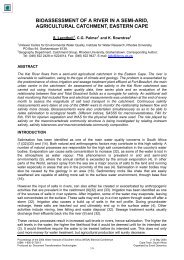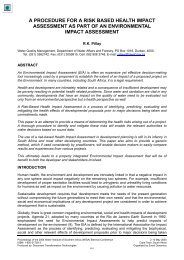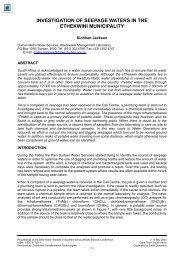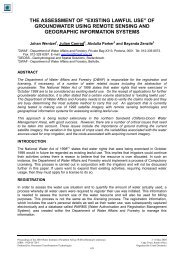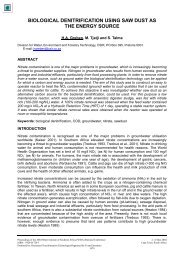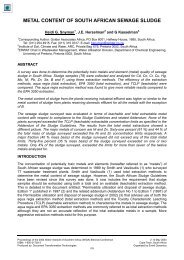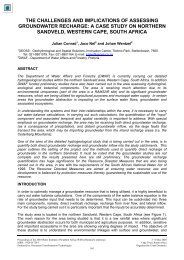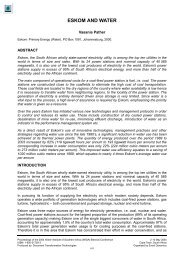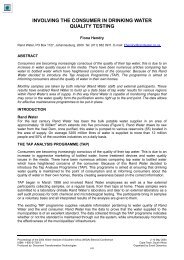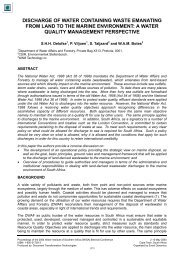Cleaner Production Makes Good Business Sense: Results ... - eWISA
Cleaner Production Makes Good Business Sense: Results ... - eWISA
Cleaner Production Makes Good Business Sense: Results ... - eWISA
You also want an ePaper? Increase the reach of your titles
YUMPU automatically turns print PDFs into web optimized ePapers that Google loves.
CLEANER PRODUCTION MAKES GOOD BUSINESS SENSE:<br />
RESULTS OF THE CLEANER TEXTILE PRODUCTION PROJECT<br />
Susan Barclay 1 , Karen Lundbo 1 , Pat Foure 1 and Chris Buckley 2<br />
1 Clothing and Textile Environmental Linkage Centre, PO Box 4464, Greenways, 7140. Tel: (021) 685 6126.<br />
Fax: (021) 689 1726. E-mail: pfoure@mweb.co.za<br />
2 Pollution Research Group, University of Natal, Durban, 4041.<br />
ABSTRACT<br />
The <strong>Cleaner</strong> Textile <strong>Production</strong> Project, a joint initiative between the Danish Government<br />
(DANIDA), the South African Department of Environment Affairs and Tourism (DEAT) and the<br />
Department of Trade and Industry (the dti), was started in June 2000 and ended in June 2003. This<br />
3-year project was funded by Danida and aimed to promote the concepts of cleaner production to<br />
the South African Textile Industry. This has been effectively achieved through programmes such as<br />
study tours to Denmark, training courses, audits, feasibility studies and a number of demonstration<br />
projects. In total, 36 textile companies and 18 other organisations participated and benefited from<br />
this project. By implementing cleaner production practices, these companies have not only reduced<br />
their use of natural resources and their impact on the environment, but have also made substantial<br />
financial savings. Already savings in the region of R 54 million per year have been identified for 28<br />
textile companies, and of this, 16 companies have already saved R 19 million / year. These<br />
savings have come from reducing water use (and therefore effluent production), energy use,<br />
chemical use, raw material use and other consumables.<br />
This poster will highlight the cleaner production options that have been implemented in the textile<br />
companies as a result of the <strong>Cleaner</strong> Textile <strong>Production</strong> Project, and report the savings achieved,<br />
both financially and environmentally.<br />
INTRODUCTION<br />
A joint initiative by the Department of Environmental Affairs and Tourism (DEAT) and the<br />
Department of Trade and Industry (the dti) prompted the Danish government into formulating a<br />
programme of assistance to South Africa in <strong>Cleaner</strong> <strong>Production</strong> in 1996. Five major industrial<br />
sectors were targeted, one of which was the textile industry. The <strong>Cleaner</strong> Textile <strong>Production</strong> Project<br />
(CTPP) was initiated in June 2000 and ended in June 2003.<br />
A life cycle approach was adopted for this project to ensure the careful examination of all the<br />
impacts of a particular textile end product, from raw materials extraction through to the end use<br />
and final disposal. The CTPP therefore focused on the entire textile pipeline, but concentrated<br />
mainly on cotton growing and textile manufacturing, as this is where the highest environmental<br />
impacts occur. The main aim of the project was to reduce the negative environmental impact of the<br />
textile industry, both at the cotton growing stage and the manufacturing stage, through a<br />
preventative approach.<br />
<strong>Cleaner</strong> <strong>Production</strong> can be defined as (1):<br />
“a preventive integrative continuous strategy for modifying products, processes and<br />
services to enhance efficiency, which improves environmental performance and reduces<br />
costs, leading to a reduction of risks and a competitive advantage”<br />
<strong>Cleaner</strong> <strong>Production</strong> also encompasses terms such as waste minimisation, pollution prevention,<br />
waste avoidance, etc. and is recognized as an important approach to leading industry in the<br />
direction of sustainable development.<br />
Proceedings of the 2004 Water Institute of Southern Africa (WISA) Biennial Conference 2 –6 May 2004<br />
ISBN: 1-920-01728-3 Cape Town, South Africa<br />
Produced by: Document Transformation Technologies Organised by Event Dynamics
More importantly, cleaner production places an emphasis on attitude change, where organisations<br />
need to question their operating practices and ask themselves how they can operate more<br />
effectively. The manufacturing component of the CTPP aimed to assist the textile companies within<br />
South Africa in achieving this change in attitude through a number of activities such as study tours,<br />
demonstration projects and training. As a result, many of the participating textile companies have<br />
successfully managed to make this shift, resulting in substantial benefits, both financially to<br />
themselves, and to the environment.<br />
This paper will highlight some of the cleaner production options implemented by textile companies<br />
during the course of the CTPP, and the resultant benefits.<br />
QUESTIONING NORMAL OPERATING PRACTICES<br />
A number of textile companies reduced water, energy and chemical use through questioning the<br />
normal operating practices. These companies invested time in investigating what changes could be<br />
made to the current process operations such that they became more efficient and reduced both<br />
utility and raw material use.<br />
By questioning the manner in which hot water was used in their wet processing department, a<br />
medium-sized textile company has managed to reduce their water use from 27 000 litres/hour to<br />
just 6 500 litres/hour – a reduction of 76%! Since most of this water is heated, this also resulted in<br />
savings in steam. This process was initiated by first investigating what the difference to the process<br />
and product quality would be if the flow rate was reduced by a small amount. When no adverse<br />
effects were noticed, the flow rate was reduced further, and then further still, until the optimum was<br />
achieved. Water reuse options between processes were also investigated such that fresh water<br />
intake was reduced even further.<br />
Many other cleaner production initiatives have been undertaken at this factory, and in total, over R<br />
5 million has been saved in the 2 years this company has participated in the CTPP, with a return on<br />
investment of approximately 1 month. The motto of this company is “challenge dinosaur standards<br />
– if you don’t, you might become one of them – extinct!”<br />
THINKING CREATIVELY<br />
A number of cleaner production changes that have been made have been as a result of companies<br />
thinking of creative methods of becoming more efficient. In most cases, these suggestions have<br />
come from in-house initiatives, where factory staff is encouraged to submit suggestions for<br />
projects.<br />
In one example, a spinning mill investigated the manner in which their yarn was packaged and<br />
found that the separator pads between the layers of cones were over engineered. After extensive<br />
investigation, a new separator was designed, resulting in savings in the region of R 700 000 per<br />
year in packaging costs.<br />
In another textile manufacturing company in Cape Town, the staff initiated a project to use the<br />
fabric off-cuts produced in the cutting department to make children’s T-shirts, which are then sold<br />
in the factory shop. This resulted in minimum fabric wastage as pattern cutting was optmised, and<br />
also a further profit to the company through the sales.<br />
Another example of creative thinking is the use of dyeing dummies. Within particular dyeing<br />
machines, the same volume of water is used regardless of the amount of fabric or yarn that is<br />
being dyeing. This means that water, energy and chemicals are effectively wasted at these times.<br />
In addition, cleaning of these machines uses large amounts of water as they need to filled and<br />
drained. It is possible to use a dyeing dummy at these times, where the excess space is taken up<br />
by the dummy, thus reducing the volume of water that is required to full the machine. This<br />
procedure has been effectively used in Denmark, and is being investigated locally by 2 textile<br />
companies.
IMPROVING HOUSEKEEPING<br />
On analyzing the number of cleaner production options implemented by the textile companies<br />
participating in the CTPP, it was evident that over 80% of these options could be attributed to<br />
improved housekeeping measures, or low hanging fruits – i.e. those changes that can be made<br />
with little or no capital investment, but which can provide a substantial saving.<br />
Opportunities that can be described as housekeeping include:<br />
• Measuring and monitoring utility use<br />
• Regular maintenance (fixing leaks etc.)<br />
• Awareness raising and training<br />
• Optimising recipes<br />
One of the most important aspects of these is the need the awareness raising. An effective cleaner<br />
production programme is not possible without the commitment from all levels of staff within an<br />
organisation. Many of the participating companies have implemented awareness raising<br />
programmes on-site and these have resulted in positive improvements in all cases.<br />
A wet processing company in Cape Town has installed information boards next to the processing<br />
machinery. Every shift, the shift operator is responsible for recording the water that has been used<br />
and the amount of product that has been processed. Key performance indicators are calculated<br />
and targets set. This information allows any person in the factory to see at a glance how efficient<br />
the process is and if there are deviations (i.e. more water used per metre of fabric than is<br />
necessary) corrective action can be taken. This has resulted in greater staff awareness and<br />
improved process control, and a reduction in water use by 8%.<br />
A second factory in Cape Town undertook a maintenance programme on their compressed air<br />
system. Compressed air is an expensive utility that is often ignored and misused within factories.<br />
As a result, there are often numerous leaks, which go undetected for long periods of time, and<br />
operators make use of it for cleaning floors etc. As a result of this programme, the company has<br />
managed to eliminate the use of one compressor, resulting in savings in the region of R 60 000 per<br />
year.<br />
By closely observing their production process, a textile manufacturer in Gauteng was able to<br />
eliminate some process steps without affecting product quality, resulting in savings in water, energy<br />
and chemicals, and a reduction of 7.5% in dyeing cycle times. This meant that production output<br />
could be increased without purchasing further equipment.<br />
INVESTING IN TECHNOLOGY<br />
In some cases, the only way in which to improve process efficiency is to make some capital<br />
investment into new technology. This could involve the installation of monitoring equipment, or the<br />
purchase of new, more modern, machinery.<br />
In one example, a textile manufacturing company replaced all their out-dated dyeing machines that<br />
required large volumes of water for processing, with a fewer number of new low-liquor dyeing<br />
machines. Not only did this result in less water being used, and as a result, less effluent being<br />
produced, but also resulted in less time being required for processing, thus improving production<br />
efficiency.<br />
A commission dyehouse based in Pinetown also turned to technology to improve their process<br />
operations. Prior to being dispatched, all fabric is cured at high temperature on a heavy fuel oil<br />
(HFO) -fired stenter. The company installed monitoring equipment such that the moisture content<br />
could be determined, thus ensuring optimum drying, preventing over drying and reducing HFO use.<br />
This also resulted in reduced greenhouse gas emissions.
AWARENESS THROUGH TRAINING<br />
Under the CTPP, four very successful waste minimisation auditor-training courses were run for<br />
management at various textile companies. These training courses were designed to raise<br />
awareness as to the concept and methodology of cleaner production, and to assist companies in<br />
implementing cleaner production programmes on-site. The course was run on a modular basis,<br />
with tasks being set at the end of each module for the participants to complete. Worked examples<br />
were used to demonstrate each stage of the process, and participants were required to provide<br />
feedback at each meeting. This often resulted in extensive discussion and exchange of information<br />
and advice between the participants.<br />
Those companies that participated in these courses, attribute the start of their cleaner production<br />
programmes to their attendance at this course, as it raised their awareness and encouraged them<br />
to start thinking differently and question current operating practices.<br />
TECHNOLOGY TRANSFER<br />
A number of technology transfer initiatives were undertaken during the course of the CTPP, one of<br />
the most successful being the study tours to Denmark. In total, 4 study tours were conducted,<br />
involving representatives from industry, government, tertiary educational institutions, and research<br />
organisations. These study tours involved presentations from companies implementing cleaner<br />
production and ISO 14000, and also visits to textile companies, design schools and government<br />
organizations. All who participated benefited greatly from both the exposure to cleaner production<br />
initiatives in Denmark, as well as from the interaction with one another on the tour. On returning to<br />
South Africa, many companies implemented improvements within their factories based on what<br />
had been observed in Denmark.<br />
In one example, a company in Cape Town managed to save an estimated R 150 000 per year by<br />
using recyclable cardboard boxes for transporting fabric between processes. Prior to this, the fabric<br />
had been stored in disposable plastic bags. This was a direct result of being a member of one of<br />
the study tours to Denmark.<br />
OVERALL RESULTS<br />
There are numerous successful case studies that can be reported as a result of the Danida CTPP.<br />
<strong>Cleaner</strong> production involves continuous improvement, and although the CTPP has officially ended,<br />
companies continue to investigate improvements, make process changes, and achieve financial<br />
and environmental savings.<br />
Table 1 lists the overall savings that were reported by participating companies as of June 2003.<br />
The number in brackets next to the figures reflects the number of companies contributing to this<br />
saving. This table only includes the known reported savings – it must be made clear that the<br />
companies may have achieved further savings than reported here and this must be followed up on.<br />
In some cases this data is over a year old, and in others the company has not ever submitted a full<br />
report on the savings they have achieved.<br />
Table 1. Summary of reported savings (June 2003).<br />
Item Annual financial saving Annual unit saving**<br />
Water and effluent 4 970 000 (12) 790 000 kl (8)<br />
Steam 2 560 000 (6) 31 000 tons (2)<br />
Energy 565 000 (3)<br />
Heavy fuel oil 1 570 000 (3) 480 kl (2)<br />
Chemicals 4 600 000 (6) 7 tons (1)<br />
Waste 1 080 000 (4)<br />
Other* 3 660 000 (5)<br />
Total 19 005 000 (16)<br />
* Other includes aspects such as raw material and consumables
The CTPP has also achieved many other results that cannot be quantified. These are listed in<br />
Table 2 together with some of the initiatives undertaken to achieve these outcomes.<br />
Table 2. Other outcomes of the CTPP.<br />
Outcome Action taken<br />
Increased awareness at industry level • Training<br />
• Study tours<br />
• Workshops<br />
• Articles in Journals<br />
Increased awareness a local government level • Training<br />
• Study tour participation<br />
• Preparation of a cleaner production<br />
handbook<br />
• Workshops<br />
Company to company interaction • Participation in training course<br />
• Study tours<br />
Awareness at tertiary education institutions • Workshops and seminars<br />
• Participation in study tours<br />
CONCLUSIONS<br />
Based on the success stories highlighted within this paper, it is clear that the Danida CTPP was<br />
successfully implemented within South Africa. Not only did the textile industry benefit from the<br />
project, but also local government and other organisations such as tertiary education institutions<br />
and research organisations. One of the main outcomes of the CTPP was the establishment of the<br />
Clothing and Textile Environmental Linkage Centre (CTELC), jointly funded by the dti and Danida<br />
for 3 years, which will continue to provide assistance to the textile sector within South Africa. In<br />
addition, those companies that have realised the benefits of cleaner production will continue to<br />
lead by example. Thus, whilst the CTPP has officially ended, it is hoped that the lessons learnt<br />
through this Project will result in cleaner production within the textile sector continuing for many<br />
years to come. It is clear that cleaner production makes good business sense.<br />
ACKNOWLEDGEMENTS<br />
This project is sponsored by the Department of Trade and Industry and the Danish Government.<br />
REFERENCE<br />
1. United Nations Environment Programme, Government Strategies and Policies for <strong>Cleaner</strong><br />
<strong>Production</strong> (2001).


